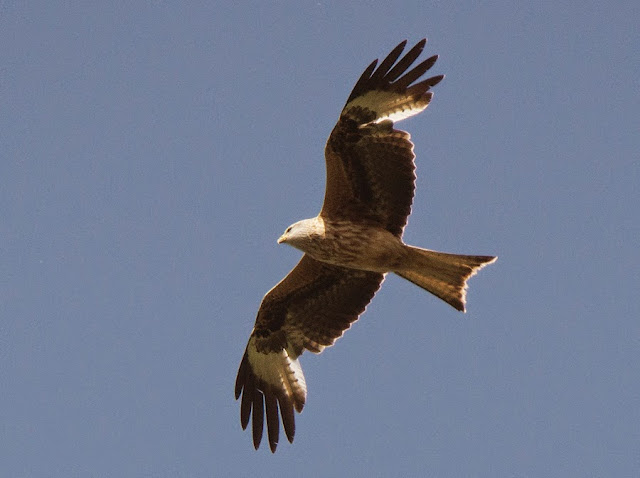 |
| Early Purple Orchid, Alex Pastures, Shadoxhurst |
Venturing down the garden at 5.30 this morning, my first thoughts were that the cold north-easterly winds had finally gone and so, too, had the crystal clear skies. Instead, it was raining steadily, the sky overcast, the air warm - perhaps a few more summer birds maybe around?. In the garden, a Green Woodpecker was calling loudly against a background of Song Thrush, Blackbird, Robin, Wren, and Chaffinch. I decided to do a dawn-chorus cycle ride, to Stone Wood in the hope of hearing most of our summer woodland birds. I headed towards Duck Lane and Stone Wood stopping regularly on the way to listen. In the village, Starlings and House Sparrows were everywhere, busy with broods under roof tops and eaves. As I left the village into countryside, no sign or sound of any summer migrants at all.
When I arrived at the top of Duck Lane, I walked slowly through to the woodland byway hoping to hear scarcer birds that I've missed so far year. Disappointingly, my list of absent birds continued. No Lesser Spotted Woodpecker this year and even the much commoner Nuthatch, and Great Spotted Woodpecker seem to be a hit-and-miss affair.
Once I'd arrived at the start of the byway there were at least 2 Nightingales in song from the woodland edge accompanied by the ever-present call of Chiff-chaffs - much more like spring, here. These two stalwarts seem to be the only common spring migrants that seem to be back in anything like the numbers to be expected for this time of year. Cycling slowly through to Stone Wood and Alex Pastures, a familiar pattern to my other visits this year, very little Woodpecker call or activity of any kind, and only one Blackcap (should be dozens). Stock Doves were calling and Jays, Crows and Pheasant were present all the way through the wood.
As I arrived at the gate for Alex Pastures, bird song improved immediately with Nightingale and Garden Warbler singing loudly from the entrance and the secondary woodland within the pasture. It's worth noting that the coppiced woodland opposite Stone Wood had no Nightingales present this morning. This area may well be populated by further migrants that may arrive in the week ahead.
Back inside Alex Pastures bird song was not as rich as I'd hoped (bar the Nightingales). Perhaps it was all down to the rain and grey overcast conditions dampening things down. The Turtle Dove purring here last week was silent or absent and there was no Cuckoo. Blackcaps and Garden Warblers were singing, and engaging in some territorial display. Two pairs of Bullfiinch criss-crossed between the woodland and scrub.
The Nightingales in Alex Pastures have returned in good numbers this spring and there song seems particularly powerful and close in the second field. Despite the bird's physical closeness though, it's impossible to see them, just brief flashes of rufous plumage quickly disappearing back into scrub. Experience tells me that this is one of the highest density populations in the Orlestone Forest complex, its neighbour, Birchett Wood has many fewer birds back so far.
As I left Alex Pastures, continuing on the byway through the woods, there was little bird song variety, - sad as this area represents some of Kent's finest woodland habitat.
Continuing on a to a favorite area of area of scrub at Stone Wood, and expecting Nightingales, I was surprised to find none present at all. Another visit is needed to work out what maybe really happening here. To confuse my Nightingale numbers further along the byway into farmland, I was pleased to find three extra Nightingale territories, with other distant birds calling from farmland hedges too. I concluded, when I arrived home, that I'd ticked off 15 Nightingales in song. Near the end of my cycle ride, at last, another summer migrant present, a Lesser Whitethroat singing from a roadside hedgerow and on the surrounding farmland Skylarks were singing too.
When I arrived home, I was thinking more about the birds I hadn't heard, such as Cuckoo, Whitethroat and Lesser Spotted Woodpecker that were absent from my ride. Perhaps May has time to get better yet?














